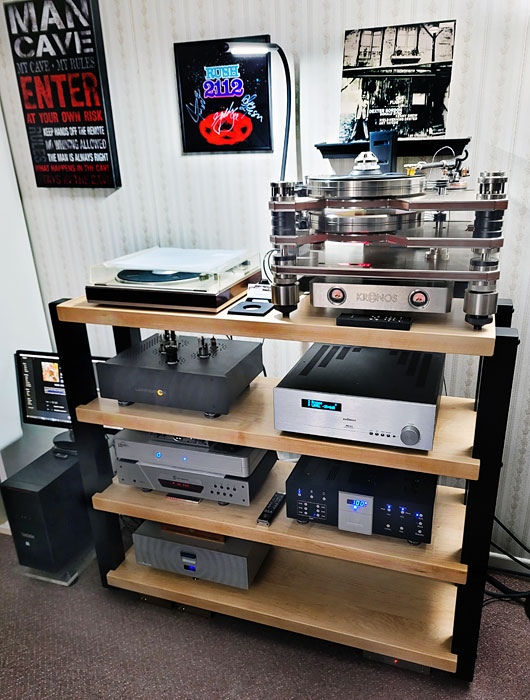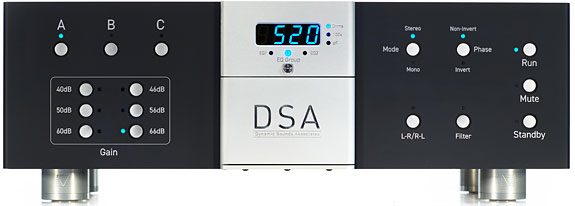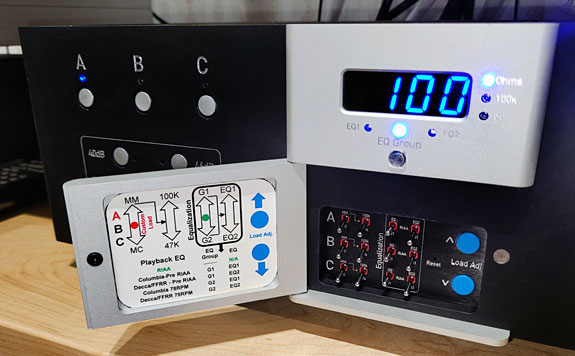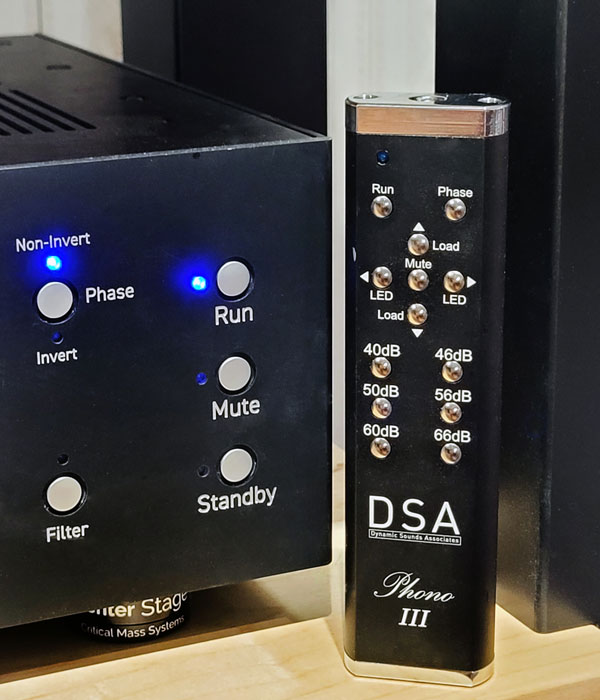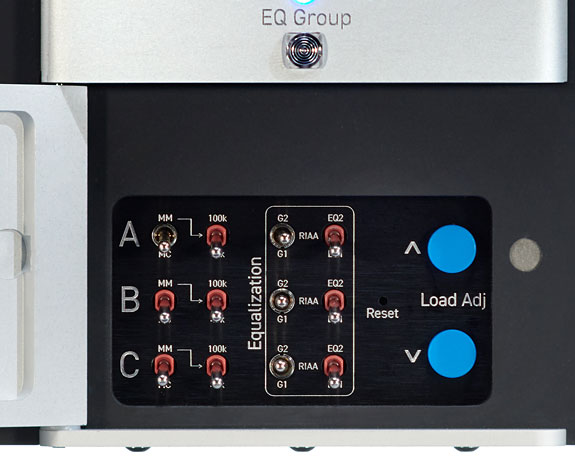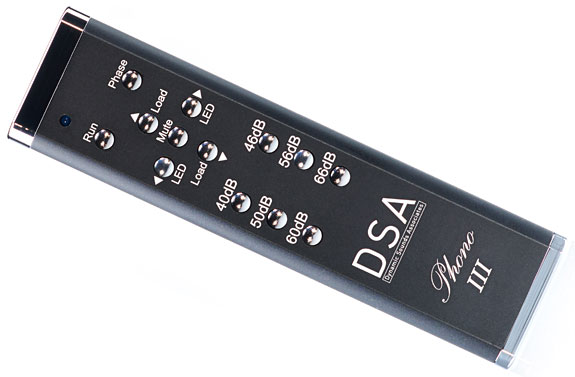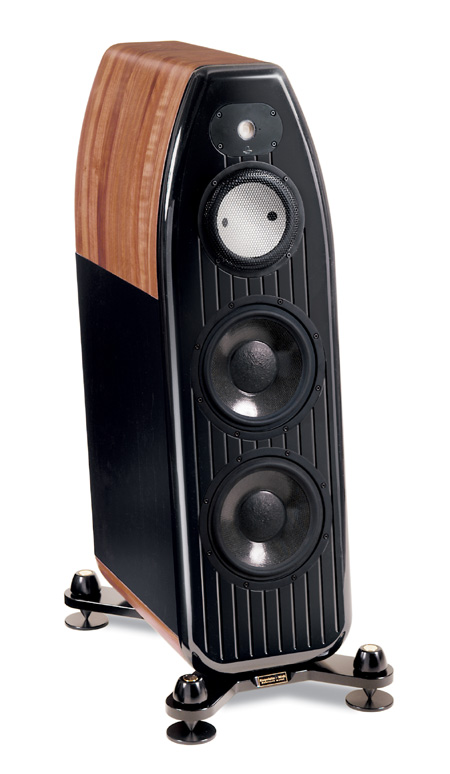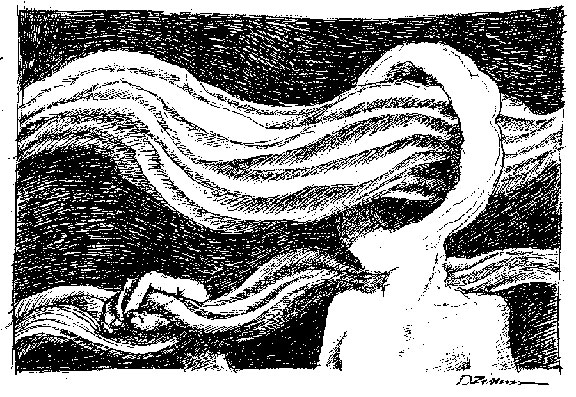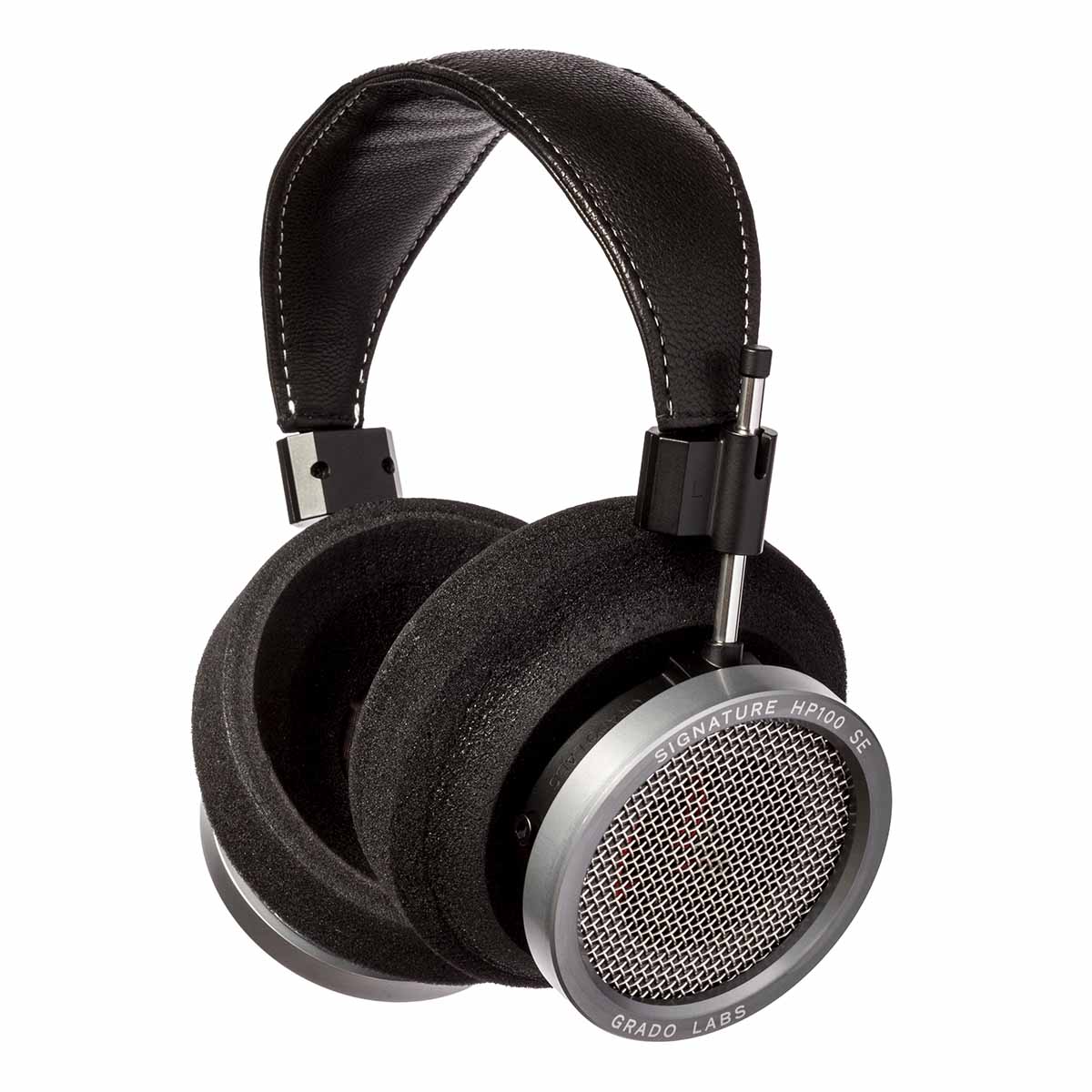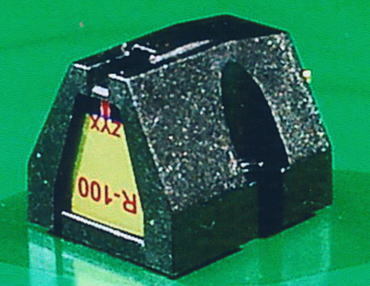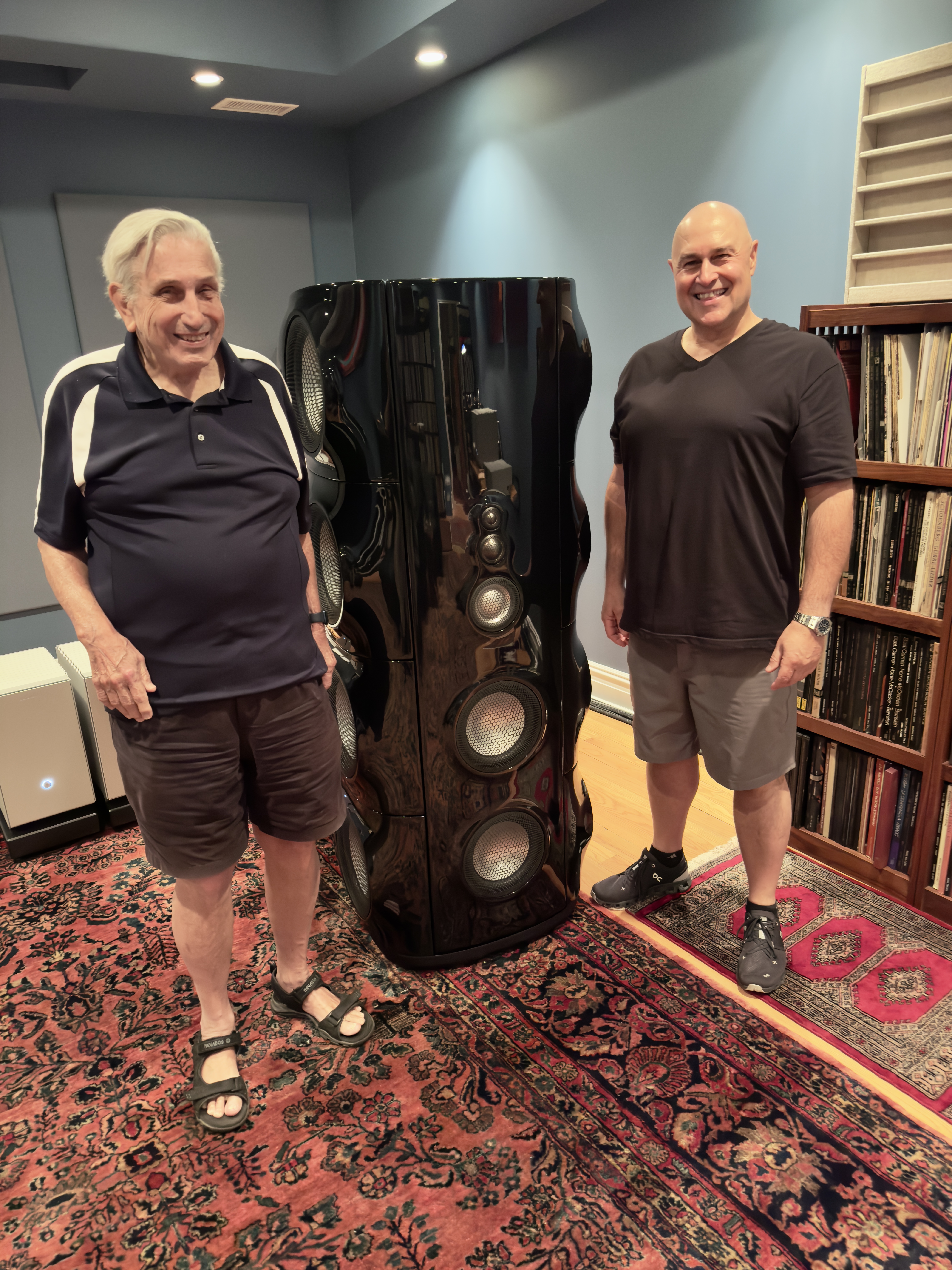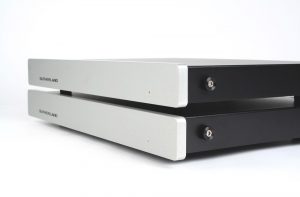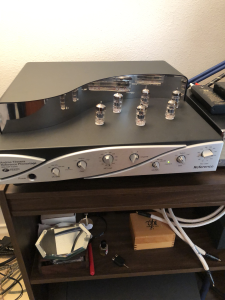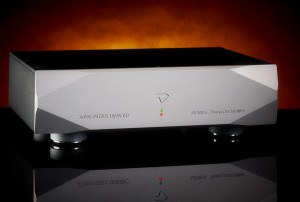With this article, Positive Feedback continues its content-sharing relationship with Enjoy the Music where Greg Weaver shares his thoughts on the Dynamic Sounds Associates Phono III Preamplifier.
Dr. David W. Robinson, Editor-in-Chief
Exceptional performance, and versatility to match.
Illustrious Beginnings
I first met Dr. Douglas Hurlburt, the incredible force behind Dynamic Sounds Associates, in the mid-1990s when I moved to Southern Maryland to manage a chain of Fitness Centers. At that time, he was a member of my newly discovered local listening group, and his home was in Potomac, MD, some 15 miles NW of D.C.
My first visit to his home with our listening group was more than merely memorable. Not only had he just finished a major revision of his KEF CS5 speakers, resulting in the publication of a paper in the Journal of the Audio Engineering Society (Vol. 48, #3, March 2000, pages 147 through 167) that revised and expanded the theory on passive radiator loudspeakers originally published by Richard Small in 1974, but he drove his newly rebuilt KEFs with a set of remarkable mono amplifiers, the precursors to his amazing Amp I, each the size of a small end table, which he had designed and built himself.
Further, he didn't even own a CD player; his only front end was a highly modified Oracle Delphi, powered by an outboard power supply of his own design, sporting a Graham tonearm and a Monster Cable Sigma Genesis cartridge, which was a collaboration between renowned designer Hisayoshi Nakatsuka (now heading ZYX) and Namiki Precision Jewel Company, who supplied the magnet structures.
Did I mention that he and Bob Graham worked together at MIT Lincoln labs? No? If you'd like to learn more about Dr. Hurlburt's education and very impressive professional accomplishments, please see the introduction to the world premiere review I did of his Dynamic Sounds Associates Pre I Linestage back in February of 2017.
I had the distinction of being the first to review his introductory product, the phono stage that heralded the arrival of DSA, the Phono-ONE, back in 2004. I subsequently purchased and used it as my reference for quite some time. In August of 2012, he introduced a wonderfully updated design in the Phono II, and though I never reviewed that iteration, it has been my reference phonostage from June of 2015 until the arrival of this further updated and advanced Phono III.
And if you've followed my work here, you'll know that, as well as introducing you to the remarkable Dynamic Sounds Associates Pre I linestage in January of 2017, I also shared the world premiere review of the Dynamic Sounds Associates Amp I in January of 2021.
Reimagine
Doug provides remarkable detail on the design, both its inspiration and execution, at the DSA website, where you can read its laboratory-grade, test-instrument-like instruction manual. For those of you who are really hungry for the nitty-gritty, I highly recommend such consumption. There he details, among other things, how the design focuses on eliminating noise while maintaining the widest possible dynamic range. For this examination, let me just offer a little about what has changed from the remarkable Phono II to realize this exceptional Phono III.
As Doug began the implementation of component changes and circuitry modifications, he would evaluate them against the sonic envelope of the previous Phono II. One of the first trials saw the implementation of newly available and tightly matched JFET devices in the amplification stage. Those listening tests revealed that while the changes were subtle, the overall improvements offered what could be described as a warmer, more involving sonic tapestry. Next, he implemented some topology changes in the amplifier gain stages, allowing him to reduce the Phono III's overall noise floor even further than that of the already remarkably quiet Phono II.
At that point, as well as clearly elevating the sonic performance, he went all in, deciding to incorporate every possible feature that could be desired by the user, including offering the added convenience of the remote-controlled operation of as many of those features as possible. Building on the collaboration he had initially formed with John Chapman to accomplish the remote control and digital counters needed to realize the Pre I linestage, John again provided the chips and programming necessary to incorporate the remarkably feature-laden, remote operation for the Phono III.
Retaining the familial appearance, at seventeen inches wide, eleven-and-a-half inches deep, and standing five inches tall (or just over six, with the included four specially modified RiZE footers from Critical Mass Systems installed), and weighing thirty pounds, the front panel of the Phono III chassis is separated horizontally into three distinct sections, matching the earlier Phono II, the Pre I, and Amp I's appearance. Here, while the central four-inch-wide section, which protrudes by a half inch, retains the natural silver finish shared by both Pre I and Amp I, the left and right sections of the panel are matte black. While this may be only an aesthetic consideration, I found that two-tone face to be somewhat less appealing, especially if one were to have the Phono III integrated into the same installation with those previously all-silver-faced products.
The breadth of the features available with the Phono III speak for themselves. It supports up to three different tonearm/cartridge combinations, allowing either single-ended or fully balanced inputs. From left to right, the back panel has its EIC power socket, a rocker power switch, a turntable grounding post, a selectable set of outputs, single-ended or balanced, followed by the three sets of inputs, A, B, and C, each offering single-ended or balanced connections.
It offers easy selection of Moving Coil or Moving Magnet loading for each input and a range of gain steps that will surely suit any need, including 40dB, 46dB, 50dB, 56dB, 60dB, and 66dB, all within 0.2dB accuracy! The manual selection controls occupy the left side of the faceplate, and your choices are stored in memory after selection and are automatically recalled and loaded on input selection… and the gain can also be adjusted from your listening position using the remote control!
The top center of the faceplate houses the Digital LED display showing the cartridge loading in use for the selected input, the equalization indicator LEDs, and the IR detector for the remote. A cleverly concealed panel under the lower half of the center of the front panel, below the LED display, and behind the DSA logo, allows for the physical control of all three inputs, including MM or MC selection, and all five of the selectable playback equalization curves, which aside from the standard RIAA curve includes those for Columbia-Pre RIAA, Decca/FFRR - Pre RIAA, Columbia 78RPM, and Decca/FFRR 78RPM. Further alternative equalization curves can be added by request.
Cartridge loading options are exceptionally flexible, offering Moving Coil resistance adjustable in 10-Ohm increments, from 10 Ohms to 2550 Ohms for each input, yielding a total of 255 distinct settings! Moving Magnet loading capacitance is also sublimely adjustable in 10pF steps, from 120pF to 1400pF, again for each input, offering a total of 127 distinct settings! The Phono III's internal memory stores the loading for each input, which is recalled and loaded upon the selection of each input whenever it is chosen. Not only may these settings be adjusted from your listening position using the remote control, but if you don't find that versatility to be granular enough, you have the option to add "custom" loading on the A input! While such custom loading cannot be stored in memory, it is selected when that input is chosen.
The right side of the face plate includes a Stereo/Mono selector (with channel differencing in mono, L-R/R-L, which allows for fine azimuth adjustment by ear), a Phase inversion selector, the Low Pass filter, and all three operation modes, Run, Mute, and Standby. And unlike the Phono II, the Phono III is fully balanced, eliminating the need to engage the mono mode when using a true mono cartridge.
Finally, the solid and comfortable remote control, aside from offering such obvious options as mute and run, allows the user to manipulate and fine-tune the display LED brightness, the gain, the cartridge loading, and to change the output phase (or polarity), from the comfort of their listening chair.
What? Like that isn't enough? C'mon…this is the most user-friendly, easiest to adjust, and most fully modifiable phono stage I have ever seen, regardless of price. While the Pre I and Amp I will no longer be manufactured, the Phono III is his dream project, and will remain in production, with full support, for the foreseeable future. And if I'm honest, though I could comfortably live without much of its über convenient remote capability (as I have managed before its arrival), it does offer you an otherwise unmatched level of both convenience and flexibility.
Portrayal
Over my time with the Phono III in my system, I had the opportunity to audition it with a number of moving coil cartridges, including an Air Tight PC-1, a Transfiguration Temper V, and an overachieving budget Denon DL-103D with the full A. J. Van den Hul treatment, which included a new boron cantilever and a van den Hul Type 1 stylus (4 x 70 µm). However, the bulk of my listening was done with my reference Etsuro Gold, loaded at 100 Ohms, and the clarity, transparency, and texturally replete sonic window opened into LPs with this über flexible phono stage in play were simply exceptional.
One of the most important attributes of any low-level signal device such as a phono stage is the degree to which it rejects, and inhibits self-generated, noise. If you'll recall in my opening discussion of how the Phono III had made advances over the Phono II, I touched upon how much attention Doug has paid to quelling noise, which has resulted in a remarkably silent performance, and tenders great dividends. When music is free to flow from such stark quietness, one that is among the very darkest I've heard from any phono stage in its class, its remarkable tranquil operation contributes significantly to enhancing every other benefit realized by this extraordinary device.
It is no secret that I consider the accurate recreation of the lowest frequencies of the audio spectrum to be utterly crucial to the authentic reproduction of the entire musical envelope, from its overall fidelity of tone color and balance, to affording a remarkably authentic representation of the acoustic of recordings.
Bass extension with the Phono III, including its resultant pitch definition, texture, and transient speed was simply unflappable during all my time with it. Listening to music as diverse as Saint-Saëns Symphony No. 3 In C Minor, Op. 78 (Mercury SR-90012), The Sheffield Drum Record (Sheffield Lab - Lab 14), or the Hans Zimmer/Benjamin Wallfisch Original Motion Picture Soundtrack Blade Runner 2049 (Epic, Alcon Sleeping Giant 88985494341), proved the bass reproduction of the Phono III to be among the most accurate and extended I have yet heard; no small feat, in all honesty. Not only could it plumb the ultimate depths—rendering subsonic information captured on some LPs—but its ability to portray the attributes of drum skin tone and texture, to regenerate the authenticity of the sound of rosin-on-bow friction as it excites the strings on double bass, or to reconstruct the attack, slam, and sheer exhilaration of an electric bass guitar string, plucked or picked into motion, is virtually without reproach.
Mid-bass and lower midrange are richly textured and vibrantly colored, helping to give instruments an almost eerie resultant intensity and body. Midrange tone is blustering with life, rich in detail, and full of harmonic bloom. Instrument fundamentals from piano, violin, guitar, human voice, et. al., are rendered so realistically, awash with texture and convincing dimensionality, as to reveal a surprisingly, and intoxicating, lifelike quality.
If you insist on unrestricted extension without etch, nuanced detail without edge or glare, and articulate, airy high-frequency performance, as I do, then the Phono III should be at the top of your short list. I was repeatedly struck by its unwavering ability to reconstruct delicate treble detail, not only rendered with engaging finesse, but served up with pinpoint spatial specificity and textural authority as well. As an example, listen to the subtle flavorings of the struck triangle buried deep stage right in the title track "Aja" from the 1977 Steely Dan masterpiece of the same name, (Cisco Music CLP-1006). Very often this instrument's delicate and ethereal contributions are all but silenced, almost concealed, by the complexity of the rest of this intricate arrangement. The Phono III fluently extricated both its subtle flavor and refined, distinct texture from the meticulously woven fabric of this complexly constructed jazz-influenced composition. Bravo!
Further, its accomplishments in decoding and reconstructing a realistic and convincing soundstage, as well as defining accurately sized images, is among the best available. Listening to the opening of Rush's "Witch Hunt" from their 1981 magnum opus, Moving Pictures (Anthem 5, UMe B0022380-01), numerous varieties of subtle percussive sounds populate the soundstage. Nothing here was misplaced, nothing wandered, and nothing was either slighted or accentuated. The opening tom roll was breathtaking, revealing not only left-to-right positioning, but front-to-back cues as well.
The intricacies of Respighi's Feste Roman /The Pines Of Rome (Mobile Fidelity Sound Lab, London Records MFQR 1-507) were unraveled with a delicacy and a superb degree of the focus of instrumental placement. The veritable cacophony of orchestration from the opening of Prokofiev's Scythian Suite (Mercury, Classic Records SR90006) was constrained to near-perfect focus. The Phono III offers an uncanny ability, bordering on the finest available, to present a realistic sense of the liveness of the room as vocals and instruments decay.
Sanction
Its overall level of performance, and the resultant level of engagement that it affords, must be recognized as representing a pinnacle of performance in its class. And given its virtually unparalleled flexibility, the insane degree of remote adaptability, and its otherwise uncolored and exceedingly neutral, natural voice, I simply cannot name another phono stage, at any price, that will allow you this level of flexibility to hone in on, and maximize, the native sonic characteristics of your chosen cartridge or cartridges.
While it falls somewhat short of delivering the ultimate in some regards, such as absolutely precise settle times, size and scale replication, and the fine dimensional articulation of all but a handful of considerably more expensive, world-class devices such as the Boulder 2108, the Soulution 755, or the utterly seductive and intoxicating Valve Amplification Company's Statement Phono, its accomplishments put it well to the head of its class. Short of investing that kind of dough, the Phono III comes as close as you could possibly want. There is no question that I could quite comfortably live with its remarkably uncolored, unassuming, and natural sonic voicing without concern.
I am forced to come to a similar conclusion that I offered with the evaluation of the superlative (and now discontinued) DSA Pre I (which was among the linestages used with this evaluation), that it offers extraordinarily refined sound that, while unmistakably exceptional, never calls attention to itself as being sonically "spectacular" or by in any way, through either flaws of commission or omission, drew attention to itself as a component. It would appear to have no discernable voice of its own, and as such, delivers a presentation in which you find yourself utterly and inescapably immersed in musical expression, never caught up in "the sound." It is one of the most affordable phono stages that can pull off this ultimate "vanishing" act and has really won me over. Most enthusiastically recommended!
Manufacturers Comment
From Alpha to Omega. With this review of the Phono III, our relationship with the audiophile press concludes the same way it began almost two decades ago... with a resplendent write-up from Greg Weaver. Dynamic Sounds Associates was but a "pipe dream" when I first crossed paths with Greg, then a fellow member of the southern Maryland "Backwoods Audio Society." The get-togethers of this audio group, where both criticism and encouragement were in abundance, provided the inspiration for my transition from audiophile hobbyist to professional.
It was with Positive Feedback's Issue No. 16 in November, 2004 (HERE) that Greg put us on the audiophile map with a review of the first edition of the Phono-ONE phono preamplifier. Since then, countless industry shows and special events, new product introductions, a gaggle of glowing reviews, retirement from my day job, and a move to Florida have transpired.
As it did when this all started, Greg's descriptions and impressions of the Phono III leave me with virtually nothing to add (or contest!). All that remains is for me is to thank Greg and Enjoy the Music.com for paying attention to a small high end audio manufacturer whose real payoff has always been witnessing the enjoyment that owners of our components experience.
Douglas Hurlburt, Ph.D., Founder and Chief Designer
Dynamic Sounds Associates
Specifications
- Type: Stereo preamplifier with phono stage
- Operating Modes: Standby, Mute, and Run
- Inputs: XLR balanced or RCA unbalanced
- Phonostage Gain: 40dB, 46dB, 50dB, 56dB, 60dB, 66dB with 0.2dB accuracy
- Moving Coil Loading Resistance: Adjustable in 10-Ohm increments (from 10 to 2550). Each input for a total of 255 distinct settings
- Moving Magnet Loading Capacitance: Adjustable in 10pF steps (from 120 to 1400). EACH input for a total of 127 distinct settings
- Variable brightness Digital LED display
- Phase inversion selectable from the front panel or remote control
- Five selectable playback equalization curves
- Remote control offers adjustability during playback of: Mute/Run to allow setting change, Display LED intensity, Cartridge loading, Gain, and Phase inversion
- Dimensions: 17" x 11.5" x 5" (WxDxH)
- Weigh: 30 lbs.
- Warranty: Three years
- Price: $19,000
Dynamic Sounds Associates (DSA)
1754 Persimmon Ct.
Naples, FL 34109
386.338.3500
Factory Direct - "à la carte productions"
386.338.3500
Check out Enjoy the Music for more articles and reviews




